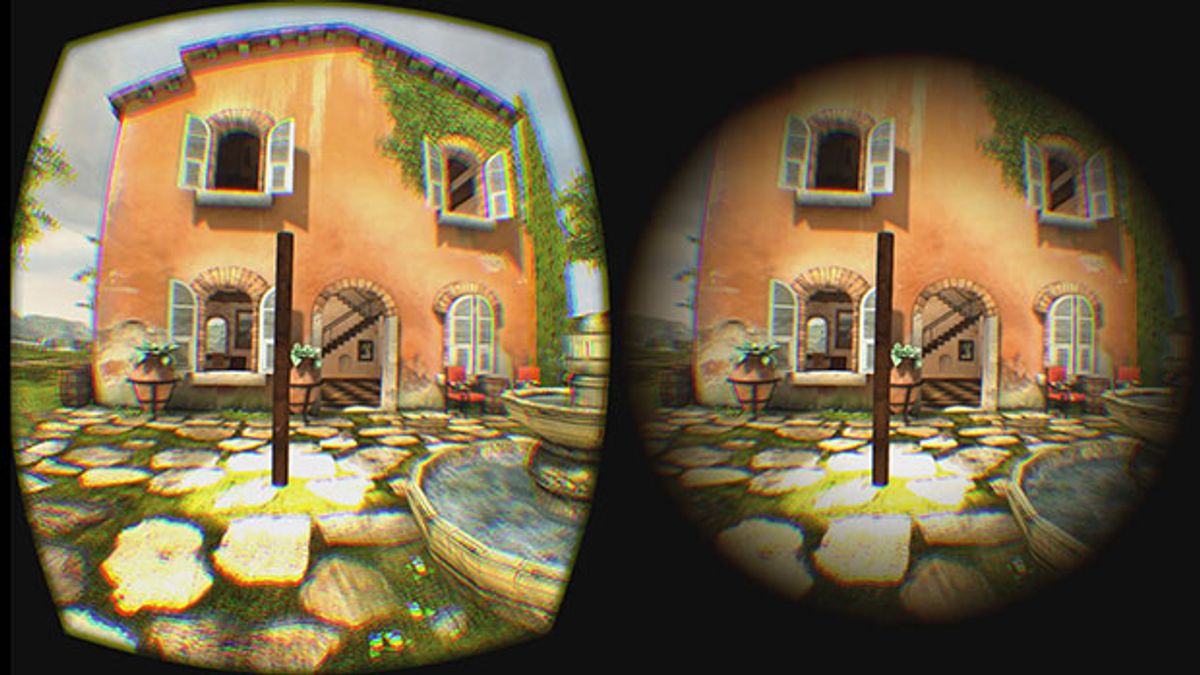We're incredibly excited for the near future of immersive virtual reality, which will let you explore worlds real and imaginary without having to leave the house or even put on clothes. Lack of clothes will come in especially handy, since a not insignificant percentage of VR users messily end up in pukesville. The disconnect between what your vision is telling you and what the rest of your (sedentary) body isn't can be disconcerting at best, and at worse, can lead to nausea, cold sweats, tossed cookies, and a desire to never try VR ever again. I speak from (bad) experience.
This is a common enough (and serious enough) problem that the National Science Foundation is tossing money at researchers with ideas on how to fix it it, and a group from Columbia University has come up with a deceptively simple but apparently very effective method of mitigating the hurl factor: dynamically restricting the field of view displayed in your VR headset while you move.
Here's the fundamental problem with virtual reality: according to your eyeballs (and ears), you're running around in an expansive new world. According to every other sense that your body has, you're sitting in a chair at your desk. Oh, and while we're on the subject of fundamental problems with virtual reality, the other big one is that as beautiful as your fake world might be it's still fake, and everything about it (the audio, the visuals, the movement, the latency, everything) simply is not as realistic as, you know, reality. Your brain isn't really designed for any of this, and for many people (me included), our brains will start to throw a tantrum, leading to the occasional technicolor yawn.
At the 2016 IEEE Virtual Reality Conference, the Best Paper Award went to "Combating VR Sickness through Subtle Dynamic Field-Of-View Modification," by Ajoy S Fernandes and Steven K. Feiner from Columbia University. Their theory was that a lot of the problems with VR stem from that annoying fact that when you move in VR, your visual sensors (eyeballs) get all out of whack with your inertial sensors (inner ears), which leads to unpleasantness, so that reducing the amount of messedupedness by restricting your field of view might help things a little bit. Here's how it works:
According to the researchers, this is based on the idea of "change blindness”: if your brain is focused on one thing, it's really easy for it to ignore other things, even really really really bizarre and obvious other things. Studies have shown that decreasing field of view in VR tends to decrease VR sickness, and slightly more obvious studies have shown that decreasing field of view in VR also tends to make the VR less VR-y. But thanks to this change blindness effect, subtly changing field of view when the user is focused on something else can yield significant improvements in the VR experience without the user actually noticing that their vision is being messed with.
The tricky part is figuring out exactly how much you can restrict field of view (FOV) and how quickly (fast enough to reduce VR sickness, but slow enough to minimize distraction), and when the best times to do that are (forward motion or rotation). The researchers did some experimental pilot studies to develop software to handle all of this, and then paid 32 "affiliates of our institution" to put on an Oculus Rift DK2 HWD with integrated 6DOF position and orientation tracking. The study participants were split into two groups, and tasked with wandering around a virtual Tuscan villa while their fields of view were dynamically tweaked with for two sessions over two days. And by jove, the FOV restriction worked:
Our data indicates [sic] that FOV restrictors helped participants stay in the VE longer and feel more comfortable than they did in the control condition. Our data also suggests [sic] that FOV restrictors helped participants experience less discomfort on their first experience, which in turn helped them transition into their next session.
FOV restrictors were unnoticed by the majority of participants, with 15 out of 30 participants selecting 1 (definitively stating “Did not notice or did not happen”) in response to whether they noticed the FOV decrease during the session in which they experienced the FOV restrictors. Furthermore, 11 of 15 participants marked a 1 for FOV change and 9 of 15 marked a 1 for brightness change, clearly indicating that it was imperceptible to the majority experiencing that condition. Yet those who did notice the restrictors generally preferred to have them.
It's always a challenge to describe the experience of VR in pictures, videos, or words, so it may seems strange that these FOV decreases can really be effective or unnoticeable or both. But that last bit that we quoted from the paper is very significant: even users who did notice the dynamic FOV restrictors doing their thing liked them, because their overall experience was better with the restrictors than without.
Happily for those of us in a physically uncomfortable love/hate relationship with VR, the researchers have already filed a provisional patent on their technique. Since it wouldn’t add much in the way of processing overhead to the VR graphics software itself, it seems like it might even be easy for developers or manufacturers to implement, meaning that we could see it sooner rather than later. Sooner would be good.
Evan Ackerman is a senior editor at IEEE Spectrum. Since 2007, he has written over 6,000 articles on robotics and technology. He has a degree in Martian geology and is excellent at playing bagpipes.



